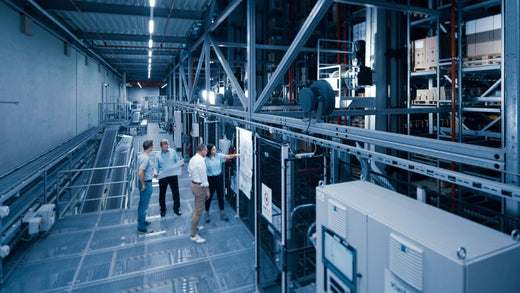
Germany's Intralogistics Market: A Promising Investment Opportunity
Share

Introduction
Germany’s intralogistics market is booming, thanks to the country’s robust industrial sector and its ongoing push toward automation. With a total addressable market (TAM) estimated at USD 4.0 billion, the demand for advanced intralogistics solutions is steadily growing. Companies specializing in automated material handling, robotics, and warehouse management systems (WMS) are at the forefront of this transformation. Industry leaders like Kion Group, Jungheinrich AG, KNAPP Group, Schwingshandl, Xproma, Klinkhammer Intralogistics GmbH, Viastore Systems, and AM Logistic Solutions are driving significant growth in the sector by offering comprehensive solutions for the full spectrum of intralogistics needs.
This blog delves into the current market landscape of Germany's intralogistics sector, offering insights into the Total Addressable Market (TAM), Serviceable Available Market (SAM), and the Value Addressable Market (VAM) — key metrics that present exciting investment opportunities.
Intralogistics Market Dynamics: TAM, SAM, and VAM Breakdown
TAM (Total Addressable Market):
Germany’s intralogistics market has an estimated TAM of USD 4.0 billion, which reflects the enormous potential for growth within the sector. As industries become increasingly reliant on automation to enhance efficiency and streamline operations, the demand for sophisticated intralogistics solutions—such as Automated Storage and Retrieval Systems (AS/RS), mobile robots, conveyor systems, and sortation systems—is on the rise. This makes the intralogistics sector a promising investment landscape, particularly for companies providing automation hardware and software solutions.
SAM (Serviceable Available Market):
SAM refers to the portion of the TAM that businesses can realistically target, based on their existing product offerings and operational capabilities. In Germany, the SAM in intralogistics is shaped by a company’s ability to meet industry-specific needs with current products, ranging from hardware to software systems. As of now, major players in the intralogistics space are focusing on industries such as logistics, food and beverage, retail, e-commerce, pharmaceuticals, automotive, chemicals, and airport operations. Companies like Xproma have found success within specific sectors, particularly logistics, food and beverage, and e-commerce, but have not yet fully penetrated industries such as automotive and chemicals due to limitations in their product offerings and strategic focus.
VAM (Value Addressable Market):
The VAM offers a more granular view of the market, focusing on the products and services that companies can effectively deliver given their strengths, market reach, and technical capabilities. The German intralogistics market features varied players, with some specializing in core hardware solutions such as AS/RS, automated guided vehicles (AGVs), and conveyor systems, while others provide specialized software for warehouse management systems (WMS) and warehouse control systems (WCS). However, companies that offer only niche solutions, such as cleanroom-specific intralogistics or specific automation systems, may experience limitations in their market penetration, restricting their ability to capture a broader share of the market.
Key Players Shaping Germany’s Intralogistics Market
The German intralogistics market is largely driven by a few key players who are pioneering the development and implementation of innovative automation solutions.
- Kion Group and Jungheinrich AG are two of the largest providers of automated intralogistics systems. Both companies offer comprehensive solutions that span across hardware, software, and services. Their expertise in automated storage systems, conveyor solutions, and robotics positions them as industry leaders in meeting the needs of large-scale manufacturing plants and warehouses.
- KNAPP Group, Schwingshandl, Xproma, and Viastore Systems are also major players, excelling in their ability to integrate automation systems across diverse industries. While each company offers a unique set of products, their focus on customer-tailored automation solutions is critical to staying competitive in the market.
- AM Logistic Solutions and Klinkhammer Intralogistics GmbH also contribute to the market's evolution with strong product offerings that cater to the growing demand for mobile robots, AGVs, and sortation systems, all of which are vital for improving the operational efficiency of warehouses and distribution centers.
Market Trends and Investment Opportunities
As the intralogistics market continues to expand, automation adoption and technological advancements are crucial trends shaping the market. With businesses increasingly seeking ways to optimize their supply chains and reduce operational costs, the demand for automated material handling solutions is soaring. Innovations like robotic process automation, smart conveyor systems, and real-time data analytics are key areas where companies are investing to meet the market’s evolving needs.
For investors, there is an immense opportunity in backing companies that are capitalizing on these technological advancements. Specifically, the market is ripe for:
- Automation hardware solutions – Companies specializing in core hardware like automated storage/retrieval systems (AS/RS), AGVs, and conveyor systems are critical to the backbone of intralogistics infrastructure. Investment in this segment offers significant long-term growth potential as businesses continue to modernize their operations.
- Software solutions – As more companies look to integrate complex logistics systems, software solutions like warehouse management systems (WMS) and warehouse control systems (WCS) offer profitable opportunities. Companies that specialize in data management, cloud-based logistics platforms, and AI-driven automation will likely continue to see increased demand.
- Customization and niche offerings – Companies that focus on providing customized automation solutions for industries such as pharmaceuticals, automotive, and food & beverage can tap into a broader market share by addressing specific customer needs.
Conclusion: A Bright Future for Intralogistics in Germany
Germany’s intralogistics market offers exciting investment opportunities, with a TAM of USD 4.0 billion and diverse market segments ripe for innovation. Companies such as Kion Group, Jungheinrich AG, and KNAPP Group are already leading the charge in providing comprehensive automation solutions. By investing in companies that specialize in both hardware and software for automated material handling, robotics, and real-time data systems, investors can capitalize on the ongoing growth of this essential sector.
With increased automation adoption, technological advancements, and a rising demand for more efficient supply chains, the intralogistics market is set to evolve into a key growth sector within the broader industrial automation landscape. For investors looking to tap into the next wave of automation, Germany’s intralogistics market presents an exciting and rewarding opportunity.